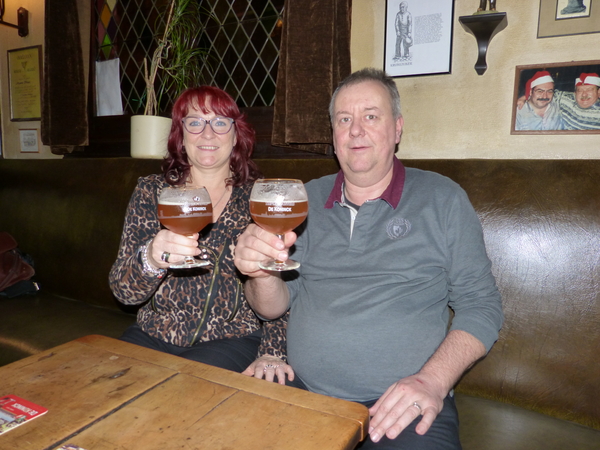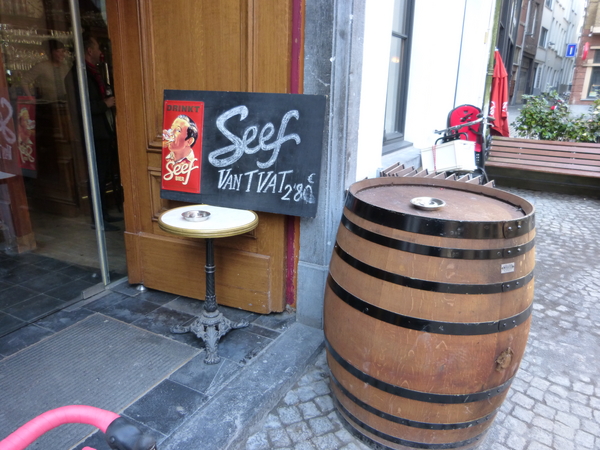Rob and Ann promise a Beer Pilgrimage to the historic taverns of old Antwerp
Added: Monday, March 24th 2014

If you fancy a beer, a bar or Flemish cuisine, mixed with some heady history of Antwerp, then let Robert Dyserynck and Ann Carruet be your guides. For 10 years their company Culinaire Wandelingen – Culinary Walks – has been organising tailored tours of the city to suit all tastes.
They offer wine, whisky and – this is Belgium – chocolate trails but I was there for the beer and they rose to the occasion with their Beer Pilgrimage. Rob and Ann picked me up from de Rooden Hoed where I had enjoyed a superb meal, each course matched with beer (see post on this site) and we headed across the Grote Markt or City Square to 7 Schaken at 24 Braderijstraat. The large, wood-panelled tavern has a large bar, with a separate restaurant that specialises in Flemish dishes.
The name means the Seven Chess Players, young men who played the game and who, in Roman times, tackled a giant who controlled the area. The giant cut off the hands of any travellers who could not pay a toll. His attackers paid him in kind by cutting off his hand and his head: the myth is celebrated by the famous statue of the Hand Thrower in the square in front of City Hall.
Sitting in the spacious and comfortable bar, Rob and Ann told me that beer is taken so seriously in Antwerp that the city has no fewer than 42 licensed beer sommeliers or professional tasters. Rob and Ann said they can tailor their events to suit different needs, including family groups or what they call “batchelors”. The latter conjures up an image of young men out on the lash but they would not be impressed by the style of a Beer Pilgrimage.
This involves a tour of pubs in the city, with small tasting glasses offered at each stop. A sommelier will advise on how to appreciate beer by sniffing the nose or aroma, then sampling the palate and the finish. No lager and definitely no Union Jack shorts.
Rob and Ann also run beer seminars in which they discuss the rich tapestry of Belgian beer styles, including Trappist and gueuze. Pilgrimages can start with a beer dinner, with each course matched with a chosen beer, as the prelude to a tour of selected pubs: the entire event can last for between four and five hours and comfortable shoes are advised.
The bar in the 7 Schaken is backed by a vast mirror that throws back the interior of the tavern. Draught beers include Chouffe, Tripel Karmeliet and Westmalle and there are bottled gueuze and kriek from Frank Boon’s lambic brewery. I sampled a beer new to me: Troubadour (6.5%), an unfiltered blond ale from the innovative Proef brewery, based between Antwerp and Ghent. It was founded by three brewing engineers who offer their kit and their expertise to commercial brewers who want to experiment, restaurant or bar owners who would like special beers for their establishments, or beer lovers and home brewers with a desire to become commercial producers. Troubadour is spiced but I found the main character to be a fruity one reminiscent of mangoes and passion fruit.

Rob and Ann set off at a gentle pace through the backstreets of Antwerp to the Quinten Matsijs (17 Moriaanstraat). It’s the oldest tavern in the city and dates from 1565. It shows its age with raftered ceilings, beams, wooden settles and latticed windows. It’s named after the painter Quinten Matsijs (1466-1529) who founded the Flemish school of painting. He was born in Leuven and specialised in portraits of people from all social classes. His best-known work, the Grotesque Old Woman, influenced the British artist John Teniel when he drew the Duchess for Alice in Wonderland.
The pub remains a haunt of local artists and writers but welcomes all comers, including British beer scribes. It’s now owned by De Koninck, part of the Duvel-Moortgat group, and it serves De Koninck’s local amber ale in the famous bolleke (little goblet) glass as well as Chouffe, Duvel and Maredsous. With Rob and Ann, I sampled a glass or three of De Koninck’s strong ale, launched in 2009, Tripel d’Anvers (8%). This is a delicious amber beer with a rich biscuit malt character balanced by peppery hops and ripe fruit.
I was intrigued by the use of the French name for Antwerp – Anvers – in the title, as the city is determinedly Flemish and you speak French with caution in some areas. Rob explained that when De Koninck opened in 1833, outside the official city boundary, it was in an area when many affluent members of the bourgeoisie lived and they spoke French as their first language. The glass that accompanies the beer is engraved with the skyline of Antwerp – or Anvers in you prefer.
*Beer Pilgrimages start at 7pm every evening except Sunday and cost €65 person, minimum of 15 people. For further information see: www.culinairewanderlingen.be or info@culinairewanderlingen.be; +32 (0) 493 72 28 56
Tofbrug is a short street just off the Grote Markt but is home to two distinctively different bars. The Elfde Gebod at No 10 is a stately building covered in ivy and wisteria. The name means the Eleventh Commandment that urges you in Biblical fashion to eat and drink to the full. The religious theme in underscored by masses of statuary inside of saints and many of the beers, including Westmalle, come from Belgian Trappist breweries. Just a few steps away you’ll find Bar Deco at No 2 Torbrug, which, as the name implies, is decidedly 20th century. The main bar is small and wood-panelled and is decorated with beer artefacts and old advertisements.
It’s the first bar in Antwerp to serve Seef on draught. Seef – pronounced “Safe” – was created by Johan Van Dyck in 2012 and he has got used to being called “an artist in beer”. He has brought back to life an Antwerp beer style that was lost in the 20th century by what Johan calls “the rise of industrial lager”. In the 18th and 19th centuries Seef was a major style in Antwerp and the surrounding area. It was produced by a number of small breweries and was drunk mainly by industrial workers. One contemporary writer described it as “the poor man’s Champagne”.
After months of research, Johan came across the descendants of one the owners of one of the breweries and they gave him the recipe they had kept in an old shoebox. He found the beer had been brewed by a blend of malted barley, wheat, buckwheat and oats with locally-grown Belgian hops. The Department of Brewing at Leuven University created a yeast culture for Johan they thought was close to the type used to make the original style.
At present Seef is brewed for Johan by the Roman brewery in Oudenaarde but he plans to set up his own plant in Antwerp as soon as possible. The beer has a double fermentation, first in the brewery and then in bottle or draught container. It’s 6.5% and has a hazy gold colour with a lemon/citrus nose and a “fresh bread” grain note, with spicy and resinous hops.
The charming Bar Deco, reflecting art and design from the early 20th century, is a fitting place to sample this historic beer on draught. www.seef.be.






